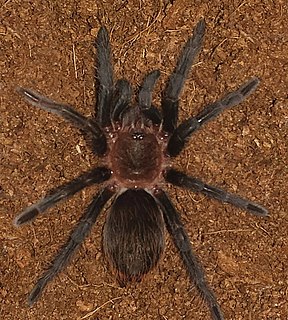
Brachypelma is a genus of spiders in the family Theraphosidae (tarantulas). They may have bodies up to 6 cm long with legs of similar or greater lengths. Some species have brightly colored legs, with red or orange marks and rings.

Aphonopelma is a genus of tarantulas native to the Americas. It includes nearly all the North American tarantula species north of Mexico and a considerable percentage of the tarantula species that range into Central America. Most are fairly large tarantulas with leg spans of 6 in (16 cm) or more. Like most New World tarantulas, all species of Aphonopelma have urticating hairs. Despite their fearsome appearance, these tarantulas are not harmful to humans and some species are popular in the pet trade. With about 90 species described so far, Aphonopelma comprises about 10% of the total number of described tarantula species. However, their taxonomy is poorly understood and species are difficult to tell apart, especially those that are brown or black without other pattern. Therefore, the actual number of species is unknown, with more species likely to be identified in the near future. In captivity, they are usually fed crickets; in the wild, they eat most insects, including crickets, grasshoppers, cockroaches, mantises, and beetles.
Aphonopelma pallidum is a tarantula of the family Theraphosidae found in Mexico. Commonly called the rose-grey, or Mexican rose, it is not available in the pet-trade.

Aphonopelma chalcodes, commonly known as the western desert tarantula, Arizona blond tarantula or Mexican blond tarantula is a species of spider belonging to the family Theraphosidae. It has a limited distribution in the deserts of Arizona and adjacent parts of Mexico but can be very common within this range. The common name "blond tarantula" refers to the carapace, which is densely covered in pale hairs, and contrasts strongly with the all-dark legs and abdomen. Additionally, these spiders have low toxicity, a long life expectancy, and several offspring.

Brachypelma albiceps is a species of spider in the tarantula family, Theraphosidae. It is known as the Mexican golden red rump tarantula or the Amula red rump tarantula. The carapace is a light golden color and the abdomen dark, covered with long red hairs. Females typically live for about 15 years. Males usually live about 5 years or up to 12 months after the last molt.

Aphonopelma anax, commonly known as the Texas tan tarantula, is a species of spider belonging to the family Theraphosidae native to southern Texas and northern Mexico.
Aphonopelma chamberlini, also known as the Paso Robles rusty red tarantula, is regarded by some sources as a tarantula species endemic to California, and by others as synonymous with Aphonopelma iodius.

Aphonopelma steindachneri is a species of spider in the family Theraphosidae, found in United States (California) and Mexico.

Aphonopelma gabeli is a species of spider in the family Theraphosidae, found in United States.

Aphonopelma iodius is a species of spider in the tarantula family Theraphosidae, found in United States. A 1997 paper combined it with three other previously described species into a single species, calling it "A. iodium". However, iodius is a neuter comparative adjective and is the correct form. Aphonopelma smithii has also been synonymized with A. iodius. A. iodius is common in the Mojave Desert to the west of the Colorado River.

Aphonopelma marxi is a species of spider in the family Theraphosidae (tarantulas), found in United States. Aphonopelma behlei and A. vogelae, at one time considered separate species, are now considered to be synonyms.

Aphonopelma vorhiesi is a species of spider in the family Theraphosidae, found in United States.
Aphonopelma bicoloratum, is a species of spiders in the family Theraphosidae, found in Mexico. As it common name aptly states it is found in Mexico, and was first described by Ronny Struchen, D. Brändle and Gunter Schmidt in 1996. It is named after the latin word "bicoloratum" meaning bicolored. This tarantula is sometimes kept as pets, and are highly desired as such, though are rarely kept as such do to the price of this spider.
Aphonopelma caniceps is a species of spider in the family Theraphosidae, found in Mexico. This species was first described as Eurypelma caniceps in 1891 by Eugène Simon, and was transferred to the genus, Aphonopelma, in 1993 by Günter Schmidt.
Aphonopelma serratum is a species of spider in the family Theraphosidae, found in Mexico. This species was first described as Eurypelma serratum in 1891 by Eugène Simon, and was transferred to the genus, Aphonopelma, in 1993 by Günter Schmidt.
Hemirrhagus is a genus of Mexican tarantulas that was first described by Eugène Louis Simon in 1903. It is considered a senior synonym of Spelopelma. Species of the genus Hemirrhagus are 5 to 12 cm long, usually black in colour, the urticating hairs on the opisthosoma are arranged in one dorsomedian patch, two dorsal paramedian patches, or two lateral patches. It is unique amongst the theraphosine genera because of the retrolateral coxal heels, the shape of the male palpal bulb, and the urticating hairs on the abdomen are reduced or completely missing. It is the only genus with epigean, troglophile and troglobitic species.

Günter E. W. Schmidt was a German arachnologist and author of a standard German work on tarantulas, Die Vogelspinnen. He has been described as one of the fathers of German arachnology.
Magnacarina is a genus of spiders in the family Theraphosidae. It was first described in 2016 by Mendoza, Locht, Kaderka, Medina & Pérez-Miles. As of 2017, it contains 4 species.

Tliltocatl verdezi is a species of spiders in the family Theraphosidae (tarantulas), found in Mexico.












